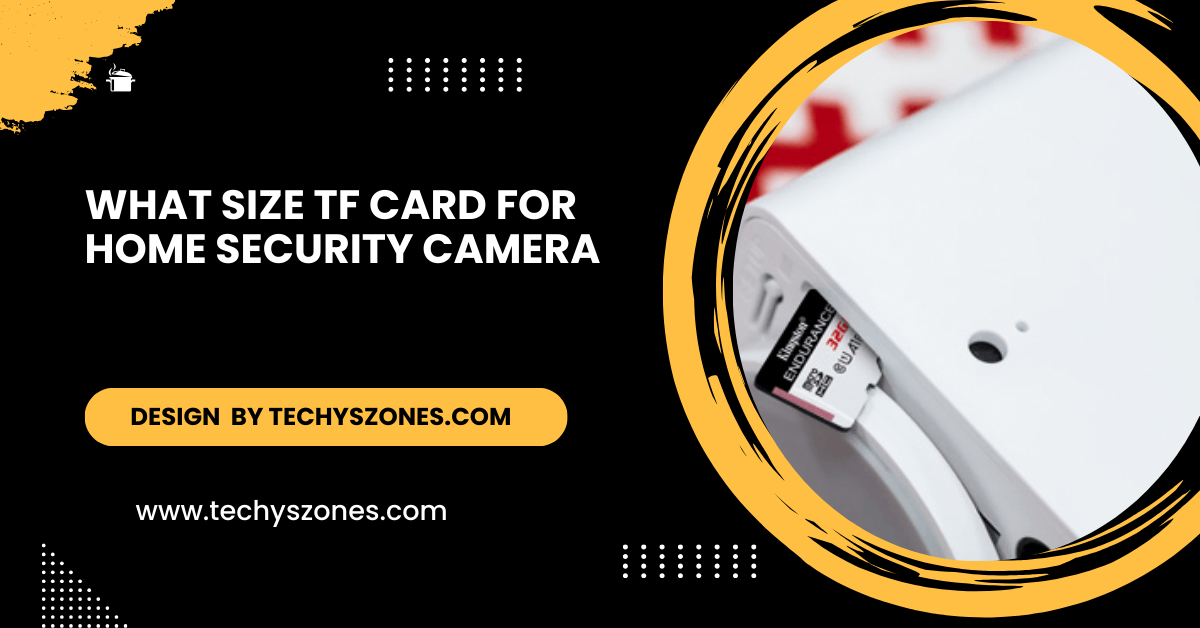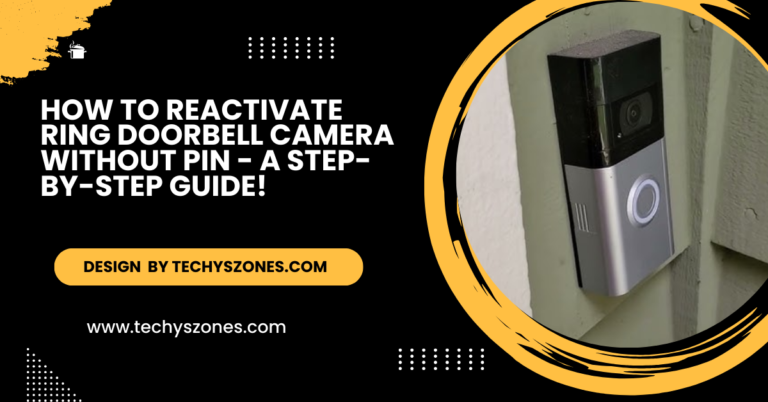What Size Tf Card For Home Security Camera – A Key To Effective Home Surveillance!
Learn how to choose the right size TF card for your home security camera, considering video resolution, storage needs, and recording modes for optimal performance.
In this article, we guide you through selecting the ideal TF card size for your security camera. We explore how factors like resolution, recording modes, and storage impact your choice. Plus, we highlight important considerations for speed, endurance, and compatibility.
Why is TF Card Size Important for Home Security Cameras?

The TF card size you choose has a direct impact on how much footage your camera can store before it begins overwriting older data. The larger the card, the more footage you can store and the longer you can retain it. Here’s why it matters:
- Continuous Recording: Some home security cameras are set to record 24/7. This means they need significant storage to handle continuous footage.
- Motion-Triggered Recording: Other cameras only record when motion is detected, which can help save space. However, the size of the card still determines how long you can store these recordings before they are overwritten.
- Event-Based Recording: Some cameras only record when specific events occur, such as a door opening or an alarm going off. For these cameras, the storage requirements can vary widely depending on how frequently these events occur.
Factors That Affect TF Card Storage Requirements:
Several factors determine the amount of footage you can store on a TF card, including:
- Video Resolution: The higher the resolution, the more storage you will need. Standard security camera resolutions include 720p, 1080p (Full HD), and 4K Ultra HD. For example, 4K video consumes significantly more space than 1080p.
- Recording Duration: If you plan to store footage for a week or longer before overwriting it, you will need a larger card.
- Compression Format: Many modern security cameras use video compression formats such as H.264 or H.265. These formats reduce file size while maintaining video quality, meaning you can store more footage on a smaller card.
- Frame Rate (FPS): Higher frame rates result in smoother videos but require more storage. A camera recording at 30 FPS will use more space than one recording at 15 FPS.
Choosing the Right TF Card Size for Your Home Security Camera:
Here’s a breakdown of the most common TF card sizes for home security cameras and their use cases:
32GB TF Card:
- Best for: Low-resolution cameras (720p) or cameras that record very little motion.
- Storage duration: About 2-3 days of continuous 1080p video or 5-7 days of motion-triggered video at standard resolution.
- Pros: Affordable and suitable for small setups with low activity.
- Cons: Limited storage; footage will be overwritten quickly in high-traffic areas.
64GB TF Card:
- Best for: 1080p Full HD cameras with moderate activity.
- Storage duration: Around 5-7 days of continuous recording or up to two weeks of motion-triggered recordings.
- Pros: A good balance between price and capacity, ideal for most home security needs.
- Cons: May still be too small for 4K cameras or systems with frequent recording.
128GB TF Card:
- Best for: High-definition (1080p and above) or cameras with frequent recording needs.
- Storage duration: Can hold 10-14 days of 1080p footage or 4-6 days of 4K footage.
- Pros: Ample storage for high-resolution cameras, long retention time for HD video.
- Cons: Slightly more expensive but worth it for long-term storage.
256GB TF Card:
- Best for: 4K cameras or environments with heavy activity where long-term storage is needed.
- Storage duration: Up to 20-28 days of 1080p video or 8-12 days of 4K recordings.
- Pros: Maximum storage capacity for most consumer-grade home security cameras.
- Cons: Higher cost but ideal for long-term storage and larger setups.
512GB or Higher:
- Best for: High-end security systems or commercial use where long-term data retention is critical.
- Storage duration: Can hold up to 1-2 months of footage depending on resolution and recording mode.
- Pros: Excellent for large-scale surveillance systems.
- Cons: Expensive, and not all cameras support cards this large.
Read More: Why Is My Camera Raw In Display P3 – Quick Guide!
TF Card Speed Classes: What You Need to Know
The speed of the TF card is another important consideration. TF cards come with different speed classes, which affect how quickly they can read and write data. For security cameras, you want a card with fast write speeds to ensure smooth recording without glitches.
- Class 10: This is the minimum recommended speed for security cameras. It can handle Full HD (1080p) video recording.
- UHS-I (Ultra High Speed): Offers faster write speeds and is ideal for 4K video recording.
- V30/V60/V90: These video speed classes are designed for cameras recording in higher resolutions, such as 4K and beyond.
Durability and Endurance of TF Cards for Home Security Cameras:

Security cameras write data to the TF card continuously, which can wear down the card over time. Choosing a card designed for high-endurance use is essential, especially if you are recording 24/7. Here’s what to look for:
- Endurance Cards: These cards are built for heavy use, often rated for thousands of write cycles. Standard TF cards may wear out more quickly in high-demand environments.
- Temperature Resistance: Since security cameras are often placed outdoors, make sure the card can withstand extreme temperatures, humidity, and exposure to the elements.
- Waterproof and Shockproof: Choose a card that can endure harsh conditions to ensure your data is safe even if the camera is exposed to rain, wind, or physical impact.
How to Check TF Card Compatibility with Your Home Security Camera?
Not all security cameras support every TF card size. Before purchasing a card, check the manufacturer’s specifications for your camera to ensure compatibility. Some cameras have a limit on the maximum card size they can support, usually capped at 128GB or 256GB. Using an unsupported card could lead to corrupted data or the camera not functioning properly.
Additionally, it’s essential to verify the card format your camera accepts, such as FAT32 or exFAT, as different formats are compatible with different capacities. For example, cards above 32GB typically use the exFAT format, which might not be supported by all cameras. Always format the card according to the camera’s guidelines to prevent any issues with data recording or playback.
How to Maximize the Lifespan of Your TF Card
To ensure your TF card lasts as long as possible, follow these best practices:
- Format Regularly: Periodically formatting the card can help maintain its performance by clearing old or corrupted files.
- Use Endurance Cards: Opt for cards designed for continuous recording to reduce wear and tear.
- Monitor Card Health: Some cameras or apps allow you to check the health of your TF card. Replace it if the card shows signs of failure or if you experience.
FAQ’s
What size TF card is best for 1080p security cameras?
A 64GB or 128GB TF card is ideal for 1080p cameras, providing about 5-14 days of continuous recording.
Can I use any TF card for my security camera?
No, it’s important to check the camera’s specifications for compatibility with TF card sizes and formats like FAT32 or exFAT.
How much footage can a 32GB TF card hold?
A 32GB card can hold around 2-3 days of continuous 1080p footage or 5-7 days with motion-triggered recording.
Should I use a regular or endurance-rated TF card?
Endurance-rated cards are better suited for security cameras as they can handle continuous recording and have longer lifespans.
Can I use a 256GB TF card in any security camera?
Not all cameras support larger TF cards, so it’s important to verify the maximum card size your camera can handle, often capped at 128GB or 256GB.
Conclusion:
Choosing the right TF card size for your home security camera depends on your specific needs. For most home setups, a 64GB or 128GB TF card offers a great balance between price and performance, especially for 1080p or 4K cameras. If you need more extended storage or are using a 4K camera with continuous recording, a 256GB card might be a better option.







